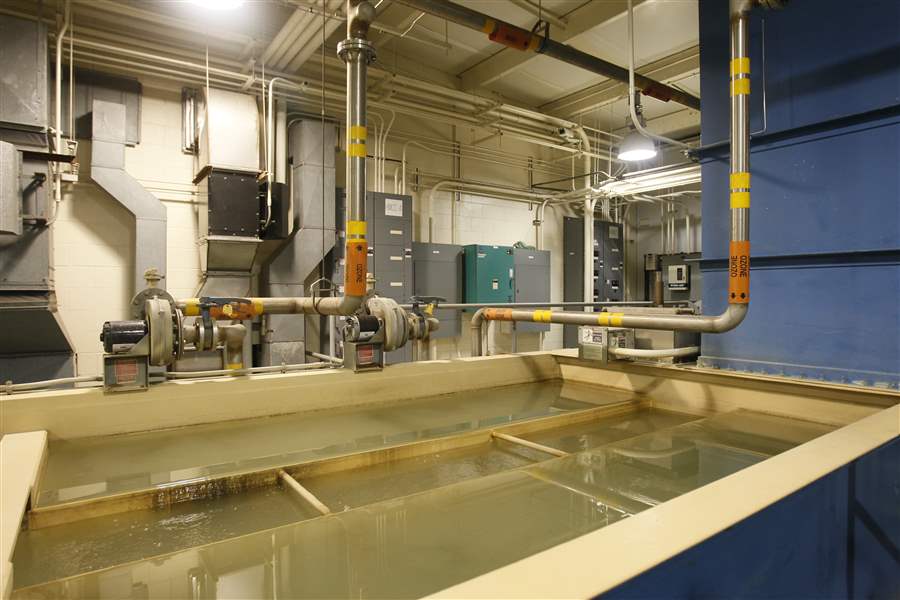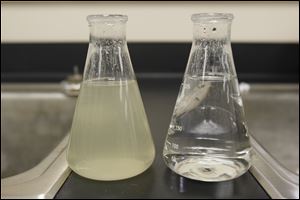
LAKE ERIE INTAKE
City water plant seeks extra $1M for algae
Council is urged to OK treatment
9/24/2013
The top of the clarifier at the water plant. The Carroll Township Water Plant was shutdown last week after it was "overwhelmed by the toxin in microcystic blue-green algae" from its water source, Lake Erie.
The Blade/Jetta Fraser
Buy This Image

The top of the clarifier at the water plant. The Carroll Township Water Plant was shutdown last week after it was "overwhelmed by the toxin in microcystic blue-green algae" from its water source, Lake Erie.
A potentially lethal toxin in western Lake Erie algae is expected to cost Toledo another $1 million to neutralize in the city’s Collins Park Water Treatment Plant, another example of how pollution generated outside the city limits can carry hidden costs for local taxpayers.
Members of Mayor Mike Bell’s administration explained to city council Tuesday they have no recourse but to ask for additional funds to keep tap water safe for metro-area homes and businesses served by city water.
“The lake is going through some changes with algae and toxins and we’ve been using a significant amount more of chemicals,” David Leffler, commissioner-plant operations, said. “Hopefully, we can get some state and federal help to reduce the trend.”
Council is expected to approve the request for an additional $1 million for treatment supplies at its regular board meeting next week. The request was unveiled and discussed at length during the board’s agenda review meeting.
This summer’s algae, ironically, is not as thick or pervasive as it was in 2010 or 2011, the two heaviest summers for outbreaks in recent years.
But scientists are learning the size of an algae bloom does not necessarily correlate with the concentration of toxins near water intakes.
They’re also learning the toxins may linger in the water, possibly for weeks or longer after the algae fades from sight, usually by mid-October.
Scientists who addressed plant operators at last week’s American Water Works Association, Ohio chapter’s annual conference, said they’ve found wind, waves, and other interactions between hydrology and weather can push the algae toxins beneath the water surface and into water intakes more than previously thought.
Intakes are below the water’s surface to get cleaner water under normal operating conditions.

On the left, water coming in from Lake Erie; on the right, water after it has been treated at the Carroll Township facility.
The situation caused Ottawa County’s Carroll Township officials to temporarily take their water-treatment system offline earlier this month because of an impending threat by a western Lake Erie algae toxin.
Mr. Leffler and other Toledo city officials, including the water plant’s chief chemist, Brenda Snyder, have told The Blade they have no backup if Toledo’s system ever became as overwhelmed.
That is an unlikely scenario, though, because Toledo’s system is much larger and more technologically advanced. But they said the city also spends, on average, an additional $150,000 a month on powdered carbon and other treatments during summers when toxins are present.
Toledo’s budget for chemicals to treat drinking water was $3 million this year, according to figures Mr. Leffler presented to council Tuesday.
A similar $1 million hike was necessary in 2010, when the budget for chemicals was $2 million, he said.
Councilman George Sarantou noted the city has nearly doubled its spending on chemicals to treat drinking water.
Councilman Lindsay Webb, who led the council agenda review meeting, said she hopes Mr. Bell will seek assistance from Gov. John Kasich.
“The seriousness of the algae bloom cannot be overstated,” Ms. Webb said.
Scientists have said farm runoff and sewage overflows are the largest contributors to western Lake Erie’s algae problem, which has reappeared almost annually since 1995 after a 20-year absence. Western Lake Erie is the Great Lakes region’s most susceptible basin, because it is the region’s warmest and shallowest.
Councilman D. Michael Collins said he believes the problem goes beyond normal runoff to include the city’s sludge deposit operation on Facility 3, a man-made island in Maumee Bay that is owned by the Toledo-Lucas County Port Authority.
Mr. Collins said the city’s contract to dump 50,000 tons of treated sludge from the Bayview Wastewater Treatment Plant there has resulted in management concerns.
“Facility 3 is a suspect point source not only for phosphorous but for E. coli and other micro-organisms that are dangerous to one’s health,” Mr. Collins said.
He said he asked unsuccessfully for the city to conduct a limited scientific study to certify that the process of the placement of bio-solids at Facility 3 was a safe practice.
Councilman Rob Ludeman urged the administration to set an example for lake polluters by moving its storage facilities away from the lake.
David Welch, city utilities director, said that’s not necessary.
“The research is pointing toward agricultural runoff. Everyone getting surface water is seeing this problem,” Mr. Welch said.
Western Lake Erie’s most prevalent algae toxin, microcystin, has killed dogs and other animals across North America. No humans are known to have died from it in this part of the world.
Scientists, however, have said it’s a toxin to be taken seriously, that exposure to high levels can cause permanent neurological damage within minutes.
Contact Tom Troy: tomtroy@theblade.com or 419--724-6058 or an Twitter @TomFTroy.
Contact Tom Henry at: thenry@theblade.com or 419-724-6079.